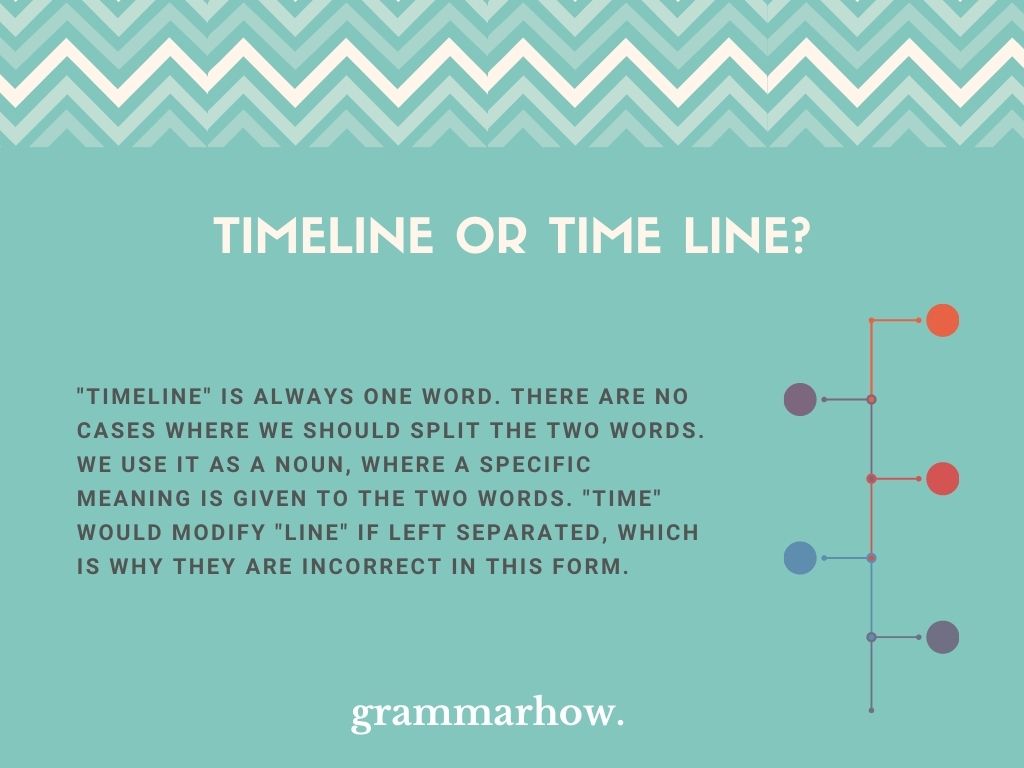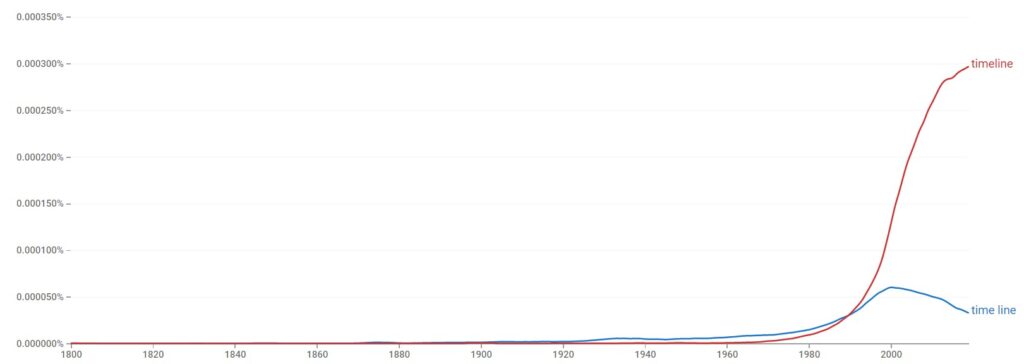Before referring to a “timeline,” in any case, you need to make sure you know whether it’s one or two words. It might seem plausible to write as two words, but this article will help you understand all the rules that surround it.
Timeline vs. Time line
“Timeline” is always one word. There are no cases where we should split the two words. We use it as a noun, where a specific meaning is given to the two words. “Time” would modify “line” if left separated, which is why they are incorrect in this form.

According to Google Ngram Viewer, “timeline” is by far the most popular choice of the two variations. You can tell because the lines are vastly different, showing that “timeline” is used much more often than “time line” as two words.

Of course, the graph does show that “time line” is sometimes used, but this is only due to human error. Even native speakers make mistakes in their writing sometimes. You have to avoid splitting the words in two if you want to be correct.
Rather than us just telling you to trust us, we can also refer you to The Cambridge Dictionary and The Oxford Dictionary. Both official dictionaries provide entries for “timeline” as one word. They both state that it is correct in this form as a noun.
Neither dictionary allows “time line” to be used, which shows that it’s not recognized as a form in English.
Is “Timeline” One Word?
“Timeline” should always be grouped into one word. We do this because it’s clear that the grouped words already have a meaning that’s relevant to our writing. “Timeline” is clearly defined, and adding a space between them would remove this definition.
The AP Stylebook typically allows us to group common nouns like “timeline.” This only applies if they’re seen frequently together, and it makes sense for the overall definition.
Here are some examples to show you how the correct variation is used:
- It’s all about the timeline. If you know the order in which things took place, you’ll have a much better time getting the questions correct.
- This timeline makes no sense! I hate it, and I wish I could do something about it! The producers won’t listen, though.
- The sci-fi timeline of this franchise is hilarious! Some things seem to happen at the completely wrong time! I should have written it!
- I like to practice my understanding of it by looking into the timeline more. It helps me to understand what happened and when.
Is “Time line” Two Words?
“Time line” is grammatically incorrect. There are no reasons to use it in this way because “time line” is not supposed to be a phrasal noun. Phrasal nouns are built from adjectives and secondary nouns, but this does not apply when using “time line.”
AP Style rules would show us that “time” would be treated as the adjective in this case. However, we are not using “time” to modify “line” as you might expect from typical English rules.
That’s why it makes no sense to write them separately like this.
These examples are going to help you remember that “timeline” is the only suitable choice:
- Correct: I haven’t researched the timeline in a few years, but I think I still know a great deal about it.
- Incorrect: The time line is all over the place! Someone needs to do something about this before the fans start to get bored.
- Correct: Do you know much about the Jurassic period timeline? I’m not sure I have all the relevant information to help me.
- Incorrect: It’s not just about the time line! There are more things going on here, and we need to be ready for them all.
Tip To Remember The Difference
It’s time to refer you to a tip that should help you remember the difference. It helped us, so we’re hoping it can do the same for you.
“Timeline” is all about time and the order of events in life. It makes sense to remove the space between the two words to save time writing it. Since “time line” is never correct, it should be easy enough to remember that the time-based noun needs no space!
You may also like: Upto or Up to – Which Is Correct? (Helpful Examples)

Martin holds a Master’s degree in Finance and International Business. He has six years of experience in professional communication with clients, executives, and colleagues. Furthermore, he has teaching experience from Aarhus University. Martin has been featured as an expert in communication and teaching on Forbes and Shopify. Read more about Martin here.
